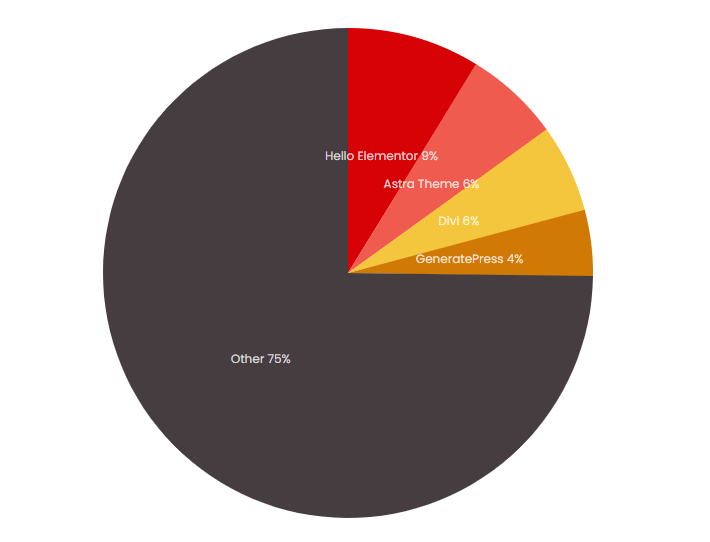35+ WordPress Statistics You Should Know in 2025

WordPress has been the go-to platform for millions of websites for the past two decades, but is it still the top choice in 2024?
To better understand this open-source CMS and its community, this blog will explore the latest WordPress statistics, revealing trends, user demographics, and the impact of plugins and themes on the World Wide Web.
Stay tuned to learn why this platform continues to be a top choice for millions!
Quick WordPress Stats and Facts from August 2024
While it started as a basic blogging tool in 2003, WordPress has grown exponentially. Here are some quick WordPress statistics to give you an insight into the strategies, and features that played a role in its groundbreaking success.
- Currently, around 861 million websites are created on WordPress.
- WordPress holds a 62.7% share of the CMS market. (W3Techs, 2024)
- WordPress has over 70,000 plugins available in the market.
- More than 30,000 themes are available for WordPress.
- WooCommerce, the largest WordPress eCommerce platform, has a 66.81% market share (6sense, 2024)
WordPress Usage Statistics and Insights
WordPress has cemented its position as the undisputed champion of content management systems (CMS). Powering over 43.5% of all websites, its reach is staggering (Kinsta, 2024). WordPress’ dominance is further solidified by its market share among websites using a known CMS. More than two out of every five such websites are powered by WordPress.
Additionally, out of the top one million websites, WordPress powers around 36.28% of them (BuiltWith, 2022). According to live reports from WordPress.com, over 409 million people read more than 20 billion pages each month.
Hosting blogs written in over 120 languages, with English as the top-used language at 71% and Spanish at 4.7% (WordPress, 2024). Here’s a table of the most popular CMS platforms and its current market share –
| CMS | % All Website | % Market Share |
| WordPress | 43.5 | 62.5 |
| Joomla | 1.8 | 2.6 |
| Drupal | 1.1 | 1.6 |
| Squarespace | 2.1 | 3.0 |
| Wix | 2.6 | 3.8 |
Source: Kinsta
WordPress Version Statistics
WordPress has released 43 major versions since its inception and while multiple versions have significantly altered its roadmap, WordPress version 5.8 is widely considered to be the most popular release.
According to the WordPress download counter, version 4.9 has been downloaded over a record-breaking 280 million times with version 4.7 holding the second place at over 167 million times.
The diagram below shows the percentages of websites using various versions of WordPress –

WordPress released its latest version 6.6 in July 2024 (WordPress, 2024). According to the historical data, reception is yet to become favorable, meaning it’s showing a steady decline with an average download rate of only 46.5 million (DisplayWP, 2024)
Generally, WordPress strongly emphasizes on using the latest WordPress versions, and it’s largely due to the continuous security updates and performance optimizations included in changes. Currently, version 6 is used by only 83.4% of all websites that use WordPress (W3Techs, 2024).
Check the detailed WordPress version and PHP statistics from here.
WordPress History Growth Trends
WordPress has seen remarkable growth in recent years. Data from W3Techs highlights a significant increase in WordPress adoption since 2013.
In just over a decade, WordPress has witnessed a remarkable 17.4% increase in website usage (Kinsta, 2023). As of August 2024, a staggering 43.5% of all websites rely on WordPress for their digital foundation, which successfully solidifies its dominance in the industry.
In 2013, over two-thirds of websites didn’t use a CMS, but by 2024, this number had dropped to less than one-third. This dramatic shift demonstrates a growing preference for CMS-driven website development, with WordPress leading the charge.
WordPress Plugin Statistics
The WordPress plugin ecosystem is massive and ever-growing. While the official WordPress Plugin Directory currently has over 59,000 free options, CodeCanyon offers more than 5,200 premium plugins, these figures only represent a portion of the available plugins.
Multiple third-party platforms contribute to the overall plugin landscape, which makes it difficult to determine the number of plugins accurately. But it’s safe to assume there are well over 70,000 WordPress plugins that are accessible to users.
However, it’s important to know that of all the WordPress plugins, 57% of them have never been reviewed.
What are the most popular WordPress plugins?
Yoast SEO is the most popular SEO plugin for WordPress, with the highest number of active installations and five-star reviews on the official plugin directory.

Currently, the most installed WordPress plugin is the Classic Editor, followed closely by the Elementor Website Builder – which has over five million active installations.

Both Akismet and Contact Form 7 are also massively popular plugins that help users check comments and contact form submissions against spam.

WordPress Theme Statistics
As of August 2024, nearly 12,000 free themes are available on the WordPress directory. This showcases the vibrant community that actively contributes to the platform. However, this is just the tip of the iceberg.
Popular marketplaces like ThemeForest add another 12,000 paid themes to the mix, bringing the combined total to over 24,000. Independent theme shops also offer countless options – both free and premium. The average price of a WordPress theme is around $57.54 (WPShout, 2017).
Since theme development is constantly evolving, pinning down a precise figure is challenging. However, a conservative estimate suggests the total number of WordPress themes easily surpasses 30,000.
What are the most popular WordPress themes?
Hello Elementor has been dominating this field for years, with 13,292 websites using it. And out of the top 1 million websites (taken from data by BuildWith), this theme accounts for 1.33% share.
Divi comes at a close second with 10,183 sites in use, securing a market share of 1.02%. Astra is similar to Divi, appearing on 10,115 sites and representing a 1.01% market share.
GeneratePress is also popular, powering 7,373 websites within the top one million websites globally, representing 0.74% of this group.

Source: BuiltWith
WordPress Security Statistics
WordPress, despite its popularity, is not immune to security threats. According to official WordPress statistics, about 90% of all vulnerabilities stem from plugins rather than the core platform itself.
Out of the common threats, 52% of reported security breaches on WordPress sites can be traced back to vulnerabilities in plugins, while 44% of hacking incidents target websites running outdated WordPress software (KeyCDN, 2022).
Cross-site scripting (XSS) accounts for about 50% of plugin vulnerabilities (AIOSEO, 2024). And around 41% of threats on WordPress sites are caused by weak spots found in third-party hosting platforms (WPSwings, 2023). Below are the major WordPress vulnerabilities, categorized by their sources –
| Vulnerability Source | Numbers Reported | Percentage of Total (1,779) |
| WordPress Core | 23 | 1.29% |
| Theme | 97 | 5.45% |
| Plugins | 1,659 | 93.25% |
Source: WPScan
While WordPress has made strides in improving its core security, website owners need to be vigilant due to its self-hosted nature.
WordPress eCommerce Statistics
WordPress, with its dedicated eCommerce plugin WooCommerce, has firmly established itself as a dominant player in the eCommerce landscape. WooCommerce’s user-friendly interface and extensive customization options have made it a preferred choice for all types of businesses.
From small-scale businesses to established brands, the platform’s flexibility and scalability have proven invaluable. WordPress retail eCommerce sales are expected to reach $7,528 trillion by 2025 (AIOSEO, 2024).
WooCommerce stores make up around 9.1% of all eCommerce sites active and out of all live WordPress sites, 21% of them use WooCommerce (Hostinger, 2024).
Wrapping Up
After seeing these WordPress statistics, it’s undeniable that this platform dominates as the leading content management system, powering almost half of all websites. Its consistent growth and substantial market share highlight its reliability, user-friendliness, and extensive support network of themes and plugins.
This evidence strongly suggests that WordPress will continue to be a dominant force in web development, adapting to meet the evolving needs of its users across the globe!
Frequently Asked Questions (FAQs)
Q. How popular is WordPress in 2024?
WordPress is still an extremely popular open-source platform in 2024, powering approximately 861 million websites globally.
Q. What percentage of the web is WordPress?
WordPress powers around 43.5% of all websites on the internet.
Q. Why choose WordPress?
WordPress is chosen for its flexibility, extensive range of plugins and themes, user-friendly interface, SEO-friendliness, and strong community support.
Q. What types of businesses use WordPress?
A wide variety of businesses use WordPress, including e-commerce stores, blogs, news sites, portfolios, and corporate websites. Its versatility also makes it suitable for small businesses and large enterprises.
Subscribe to Our Newsletter
Get the latest WordPress tutorials, trends, and resources right in your inbox. No Spamming, Unsubscribe Anytime.

Thank you for subscribing to our newsletter!
Table of Content
- Quick WordPress Stats and Facts from August 2024
- WordPress Usage Statistics and Insights
- WordPress Version Statistics
- WordPress History Growth Trends
- WordPress Plugin Statistics
- What are the most popular WordPress plugins?
- WordPress Theme Statistics
- What are the most popular WordPress themes?
- WordPress Security Statistics
- WordPress eCommerce Statistics
- Wrapping Up
- Frequently Asked Questions (FAQs)
- Q. How popular is WordPress in 2024?
- Q. What percentage of the web is WordPress?
- Q. Why choose WordPress?
- Q. What types of businesses use WordPress?













